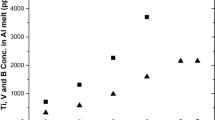The article provides results of testing excess introduction of vanadium into a molten aluminum cell through baked anodes. This stage of special technology is preliminary and required before the boriding heavy metal impurities in molten aluminum. The requirement of a preliminary stage is dictated by the presence of an insulating aluminum carbide layer on the surface of the carbon hearth that reduces the efficiency of aluminum boriding technology. The specific properties of vanadium and its compounds make it possible to organize chemical cleaning of the cathode from an Al4C3 layer, replacing it with a VC substrate. It is shown that with constant introduction of vanadium into melt dynamic equilibrium is established between vanadium and its compounds entering the cell and removed from it. Stabilization of a VC-coating requires organization of boriding technology for molten electrolyte and aluminum, creating a viscous low-mobility layer of a metal-boride Me–B suspension wetted with aluminum on the hearth.



Similar content being viewed by others
References
E. S. Gorlanov, A. A. Batrachenko, B. Sh. Smailov, and A. P. Skvortsov, “Testing baked anodes with increased valadium content,” Metallurg, No. 1, 67–73 (2018).
S. Rolseth, E. Skybakmoen, H. Gudbrandsen, and J. Thonstad, “Studies on possible presence of an aluminum carbide layer or bath film at the bottom of aluminum electrolysis cells,” Light Metals, 423–428 (2009).
Ø. Østrem, Cathode Wear in Hall-Heroult Cells, Ph.D. thesis, Norwegian University of Sci. and Technology, Trondheim (2012).
E. S. Gorlanov, G. V. Arkhipov, and A. M. Ivanova, “Development of technology for creating aluminum wetted coating on a carbon cathode. Part 1. Sequence of electrodeposition of Ti and B from cryolite melts,” in: Proc. XXXI Internat Conf. IKSOBA and XIX Internat. Conf. “Aluminum Sibirii” [in Russian], Krasnoyarsk (2013), pp. 634–642.
T. Li, S. T. Johansen, and A. Solheim, “Detailed model of electrochemical cathode wear in Hall-Heroult cells,” Light Metals, 831–836 (2015).
T. Li, S. T. Johansen, and A. Solheim, “Uneven cathode wear in aluminum reduction cells,” Light Metals, 927–932 (2016).
E. S. Gorlanov, V. Yu. Bazhin, and A. A. Vlasov, “Electrochemical borating of titanium-containing carbographite materials,” Russian Metallurgy (Metally), No. 6, 489–493 (2017).
L. E. Bodrova and É. A. Pastukhov, “Reaction of vanadium carbide with molten aluminum and copper,” Rasplavy, No. 5, 70–73 (2012).
N. Iqbal, et al., “In situ investigation of the crystallization kinetics and the mechanism of grain refinement in aluminum alloys,” Mater. Sci. and Eng., A 416, 18–32 (2006).
Robert Schulz and Sylvio Savoie, US Patent 8741185, B2 Cl.C25C 3/08. Composite Materials for Wettable Cathodes and Use Thereof for Aluminum Production, Hydro-Quebec, Appl. No. 13/122243; Filed: Sep. 29, 2009; Date of Patent: Jun. 3 (2014).
Robert Schulz and Sylvio Savoie, RF Patent 2487956, МPК С29/00. Composite Materials for Wetted Cathodes and Their Use in Aluminum Production, Claimant and Patent Holder Hydro Quebec (SА), 2011115571/02, Claim 09.29.2009, Publ. 07.20.2013, Bull. No. 20.
Author information
Authors and Affiliations
Corresponding author
Additional information
Translated from Metallurg, Vol. 62, No. 10, pp. 67–70, October, 2018.
Rights and permissions
About this article
Cite this article
Gorlanov, E.S., Batrachenko, A.A., Smailov, B.SA. et al. Role of Vanadium in Aluminum Electrolyzer Melts. Metallurgist 62, 1048–1053 (2019). https://doi.org/10.1007/s11015-019-00752-8
Received:
Published:
Issue Date:
DOI: https://doi.org/10.1007/s11015-019-00752-8




